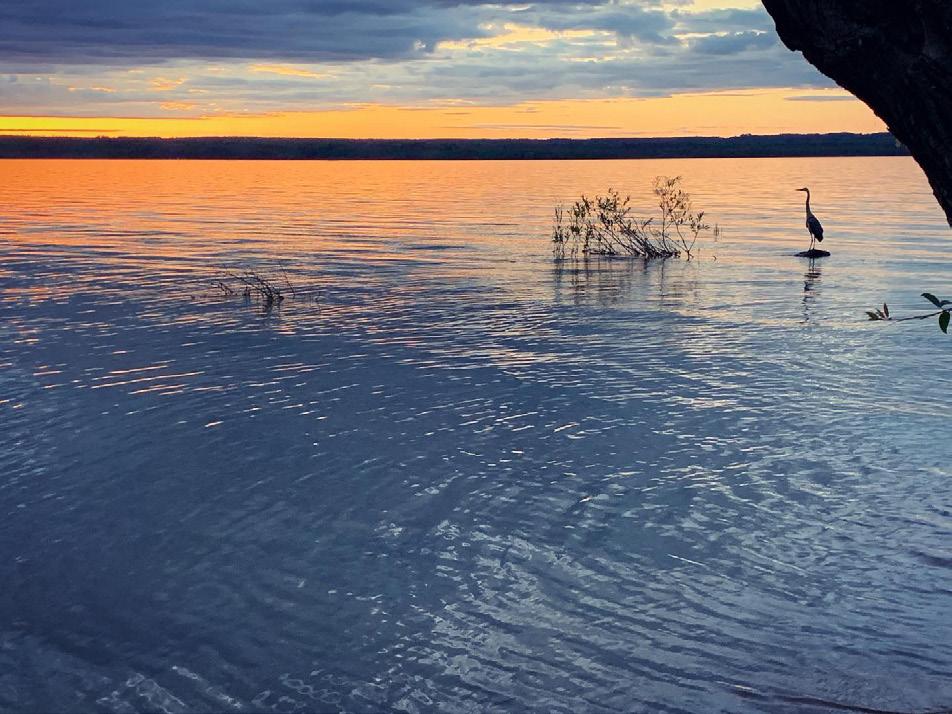
19 minute read
Along the Shore
Three businesses in downtown Grand Marais were destroyed by a fire on Monday, April 13: Crooked Spoon Café, Picnic & Pine, and White Pine North. | WTIP
Fire ravages Grand Marais businesses
Advertisement
GRAND MARAIS—Three downtown Grand Marais businesses were destroyed by a daytime fire Monday, April 13. It may seem surprising that fire chief Ben Silence says, “We got pretty lucky.”
Strong northwest winds fanned the flames and allowed the fire to rage through three old, mostly wooden buildings. The lucky part was that firefighters were able to contain the fire to those structures and thus protect the remainder of the downtown.
Silence said the Grand Marais Fire Dept. was paged at 12:23 p.m. for a fire that originated at the Crooked Spoon Restaurant. Firefighters were on the scene in 10 minutes to find fire engulfed the rear of the restaurant and the adjacent businesses, White Pine North and Picnic and Pine were burning, too. As fire fighters were setting up their hose lines, Silence noticed the cedar shakes and façade on the nearby Set Out T-shirt shop were starting to burn. He quickly had members of his crew extinguish those flames and wet down the building to keep it safe.
Pushed by the wind, it didn’t take long for the blaze to fully engulf all three buildings. Silence was concerned it might spread to other structures. Sven and Ole’s Pizza was separated from White Pine North by an alley. He said the pizza parlor had a metal roof, which prevented it from being ignited by burning debris. Fortunately, the wind-blown debris didn’t ignite any of the structures across Wisconsin Street, although there was a spot fire in the grass at Bear Tree Park.
The fire was so furious firefighters were unable to enter the buildings.
“Once the fire got into the eaves and the voids in the attic space, there was nothing we could do,” Silence said.
While firefighters struggled to contain the fire, sheriff’s deputies struggled to contain the onlookers. Even though they had established a perimeter a safe distance from the fire, onlookers were standing shoulder to shoulder, ignoring social distancing, and sneaking around barricades to get closer to the scene. At one point, Silence looked up to see a woman and her children, who had walked along the lakeshore by the Lake Superior Trading Post, crossed over fire hose lines and approached the scene via the vacant lot beside the Bluewater Café. He had to summon a deputy to chase them off the scene.
While there were three propane tanks in the vicinity, they did not ignite, contrary to rumor. The popping noise onlookers heard was from a vehicle fire behind the buildings as the airbags and tires exploded.
Within a couple of hours, the fire reduced the buildings to rubble. Firefighters were unable to extinguish all of the hotspots. Silence called in a county excavator to move the rubble so firefighters could carry on with the mop up operation. He said the state fire marshal was already on scene and they kept the excavator away from the fire’s point of origin.
“I never thought I’d call in an excavator to raze half a city block,” Silence said.
Firefighters worked through the night to complete the mop up. In addition to the Grand Marais Fire Dept., mutual aid was provided by volunteer departments from Lutsen, Colvill and Maple Hill. Also on the scene were the Cook County STOP team, members of Cook County Search and Rescue, Cook County Sheriff’s Dept., the Border Patrol, Minnesota DNR Enforcement and the North Shore Health Ambulance. Silence was especially grateful to Mike’s Holiday for providing snacks and drinks and the Cook County Chaplain’s Association for providing Subway sandwiches to the firefighters.
He was most thankful there were no injuries and the devastating fire was contained.
“I’m super thankful the buildings weren’t occupied,” he said, “because they went so quickly.”
There has been an outpouring of support for the families who lost their businesses and buildings to the fire.
“The community has been incredible,” said Kelsey Kennedy, owner of Picnic and Pine. “All of the community leaders and small businesses have reached out to us. We’ve even heard from people who love Cook County and live far away.”
For Kennedy, it is time to hit the pause button and spend time with family before moving forward.
“I’m trying not to make decisions right now,” she said. “I’m taking time to figure out what my family needs and what comes next.”—Shawn Perich



GRAND MARAIS—Many of us dream of finding a partner we want to spend our lives with. Someone we can love and see a future with. Someone we can build a home and family with. What if you found that person, they lived close by and every time you went to visit them you had to get permission from a government agent carrying a gun? That’s the situation my fiancé and I find ourselves in.
I live in Grand Marais and my fiancé, Lara Hollway, lives in Thunder Bay. Our homes and communities are less than two hours apart along a breathtaking stretch of highway 61 that attracts tens of thousands of tourists every year. We live in the same forest, speak the same dialect of the same language, have the same cultural background, and gaze out upon the same big, blue lake every day. And yet, there is an imaginary line that separates us.
The border itself is real enough. At the only road crossing for hundreds of miles to the east or west, the Pigeon River demarks the border between Ontario and the Grand Portage Reservation in northeastern Minnesota. A body of water is a natural separation that makes sense to the mind, but the arbitrary selection of this one river and these series of lakes in a vast, wild land spot marked by thousands of lakes and sliced through by hundreds of rivers seems arbitrary at best. Somehow we ended up on different sides of the divide.
For the most part, the border has been an interesting diversion within our relationship and never a great obstacle. We have been crossing every week and have become known to the border guards on both sides. We now keep our passports in the glovebox and have developed the tendency to think about the border as a formality and a quaint little part of our relationship. It seems a little silly and unimportant. Surely the rules don’t apply to us. The vast immigration apparatus and legal system are designed for threats to national security from overseas, not from next door.
We understand the necessity of securing international points of entry, but Thunder Bay and Grand Marais are hardly foreign to each other. In fact, a village in Quebec or Hawaii would be much more exotic. Even going to Toronto or Minneapolis is a greater culture shock. And yet, the rules are the rules and they are applied uniformly throughout both nations.
I can no easier immigrate and work in Thunder Bay than a citizen of Germany, Afghanistan or The Philippines would be able to. The friendly faces of the customs officers at the Pigeon River can turn cold and immovable when ordered to deny entry. This became our new reality in mid-March when the Covid-19 pandemic closed the U.S./Canadian border and we were suddenly separated by a physical barrier that became more real than symbolic.
We are now in a holding pattern and playing a waiting game. On April 18 both governments extended border restrictions for another 30 days. Our relationship now depends on creative ways of staying in touch. We have had ‘dates’ on Skype, Google Hangouts and Zoom. We had a virtual dinner to
Living on opposite sides of the border, Corey Belt and his fiancé Lara Hollway
are now in a waiting game while the border is closed. | SUBMITTED

gether that included cooking the same meal at the same time (pasta with veggies and marinara sauce) and then eating together while drinking a glass of the same wine (cabernet sauvignon). A few weeks ago, we both hiked to High Falls from our respective sides of the river and waved, smiled and yelled to each other over the sound of the roaring falls. The near reunion was bittersweet. It was a blessing to see each other, and a curse to be so close and yet so far apart.
We are both confident that our relationship will survive this forced exile, but we are also both looking forward to the re-opening of the border with great anticipation. This situation has made us realize how many ties we have on both sides of the border and how closely our two communities are intertwined.
For many of us who live in this region, Lake Superior is our shared identity and the force that binds us together rather than the two nation states that share her waters. The drive between Grand Marais and Thunder Bay is an hour and a half of unbeatable scenic beauty. I look forward to taking that drive again in the near future. —Corey Belt
Safe Driveways in Rural Areas
Driveway Access for Emergency Vehicles Emergency personnel try their best to respond to calls in a timely manner. Planning for access by emergency vehicles improves safety for homeowners and their families. This is especially important in rural areas where response times may be considerably longer than in cities.

Driveway Width, Height & Grade For emergency vehicles to safely access your property, your driveway must have an all-weather surface that can support large, heavy vehicles. Vegetation must be cleared to the following standards: • Haveanunobstructedverticalclearanceof14feet. • Haveatleasta12-footwidedrivablesurface,witha 2-footclearzoneoneachsideofthedriveway (16-feetoverall). • Drivewaymustnotexceed12%gradeoverall.

Cook County Firewise 411 W 2nd St, Grand Marais, MN 55604 firewise@co.cook.mn.us Phone: 218.235.0899
www.cookcountyfirewise.org
COOK COUNTY
V O T E D B E S T W I N E

Virtual Date Nights Thurs. 6-7:30 p.m.
Order Pickup Mon.-Fri. Noon-5 p.m.
The Hayes family enjoying some beach time at Split Rock State Park: Devin, Aneliese, Jenny and Hayes. | SUBMITTED
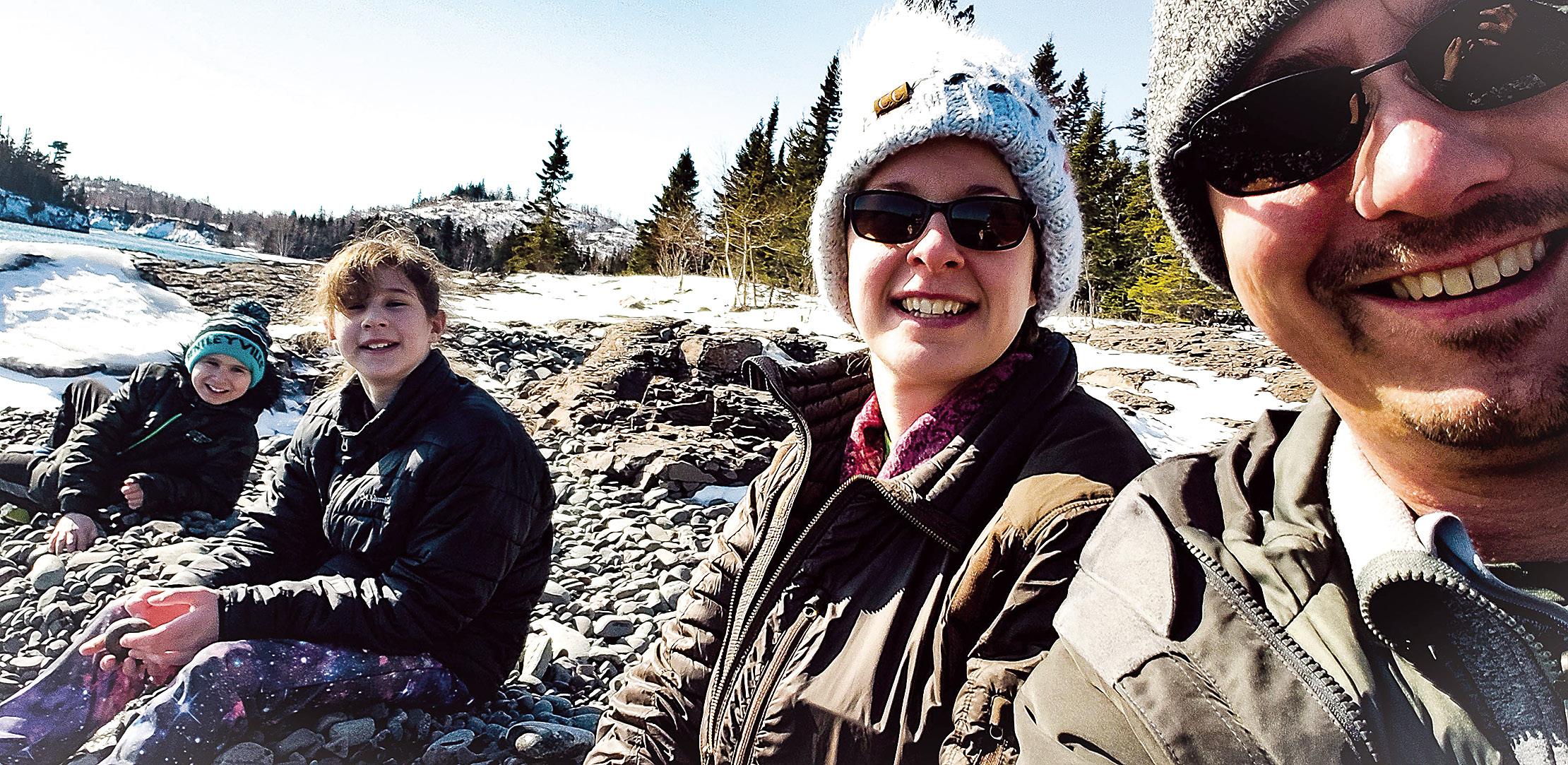
New light keeper finds North Shore magic at Split Rock
TWO HARBORS—In fall 2019, longtime Split Rock Lighthouse site manager Lee Radzak retired, passing the torch to Hayes Scriven. Hayes and his family moved into the light keeper’s residence this winter. Northern Wilds reached out to Hayes to learn more about the man who is now caring for the historic lighthouse.
Hayes comes to Split Rock with a solid background in Minnesota and Wisconsin history. While in college at the University of Minnesota-Duluth, he was an intern at the Richard I. Bong Veterans Historical Center in Superior, Wisc.
After college, he served as the executive director of the Northfield Historical Society in southern Minnesota for over 11 years, starting there as the exhibits and education coordinator.
He and his wife, Jenny, wanted to be farther north, so when the director position for the Richard I. Bong Veterans Historical Center came open, he applied.
Hayes says, “I had always joked, that the only job that would ever take me away from Northfield was a job up north. When the job at the Bong became open, it was the perfect opportunity.”
He oversaw the Bong Veterans Historical Center from 2017 until November, 2019, when he accepted the light keeper’s job at Split Rock.
Hayes is not a North Shore native—he grew up in Nerstrand, Minn., about 15 miles outside of Northfield. But he has always had a fondness for the iconic lighthouse. He doesn’t remember his first visit to Split Rock at just 2½ years old, but his parents recorded the moment with a photo of their little boy, gazing up at the 54-foot tall lighthouse.
There were many other trips north with his grandfather, starting when Hayes was 13 years old. The pair made annual treks to the Boundary Waters Canoe Area Wilderness, exploring the North Shore along the way.
His first visit to Split Rock when he was in college was with his girlfriend, Jenny, now his wife. He later proposed to her on top of Day Hill, the bluff in Split Rock State Park that gives panoramic views of Lake Superior and the lighthouse.
“The site and the North Shore has held a very special place in our hearts for many years,” says Hayes.
A new lighthouse keeper is a big change for the site, which is a National Historic Landmark managed by the Minnesota Historical Society. Former lighthouse keeper, Radzak managed the site for 36 years. We asked Hayes if he knew Radzak.
Hayes jokes that “history geeks” always seem to find one another. Shortly after moving to Two Harbors, Hayes was hosting a trivia night at Castle Danger Brewery. Lee and his wife, along with a Split Rock program manager, Jennifer Niemi, came in to play and the rest, as they say is history.
We asked Hayes if Radzak gave him any advice as he passed the torch. Hayes says Radzak suggested that he run the site like it’s his own business. Words of wisdom that Hayes plans to follow, as that was also his philosophy at the other organizations where he worked.
“If I did not fundraise, increase attendance, or increase membership, we would not be able to keep the doors open,” he says. “Also, you have to have passion for what you do. If you don’t have passion, your business will fail.”
And Hayes adds, “Lee and I will continue to chat; he has a wealth of knowledge that I need to try and download from him.”
However, there may be some changes ahead at the site.
“We are going to be introducing some small programmatic changes this year that will give our guests some more to do while they visit,” explains Hayes. “We are creating pop-up programs—short 20 minute interactive presentations on a variety of topics. In addition, we hope to offer some more specialty tours which can enhance the experience at Split Rock.”
Hayes and his family—wife, Jenny and children Devin, and Aneliese—are now residing on site and loving their new home. Hayes says, “We are very passionate about the outdoors, so being in the state park and living so close to Lake Superior is just a dream come true.
“The first morning we woke up in the house, I looked out the bedroom window and a bald eagle was coming right at the house and flew right over the top. It was a very magical moment, and I knew right then, we are in a very special place.”
Hayes says he will work to share that feeling with the public. “We hope everyone that visits Split Rock will have the same connection and feelings that we all do to the site
A tiny boy and a big lighthouse; Hayes Scriven at two and a half
years old. | SUBMITTED
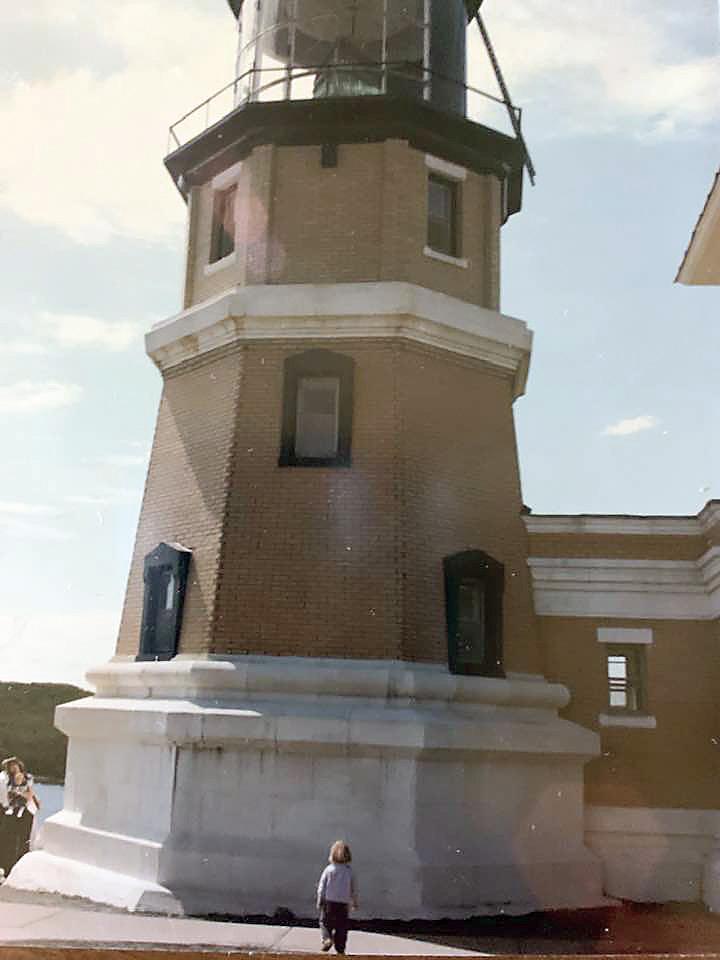
and the North Shore. It is hard to describe so I have been calling it ‘North Shore Magic.’”
“My goal is to make every guest feel the ‘North Shore Magic,’” says Hayes. —Rhonda Silence
COVID UPDATE
At press time, access to Split Rock Lighthouse State Park is currently restricted due to the COVID-19 national emergency, however work continues on programming for when the historic site is once again open to the public.
Solbakken Resort on Superior 218-663-7566 800-435-3950 4874 W Highway 61, Lutsen www.solbakkenonsuperior.com Kayak & Canoe Rentals 1/2 and Full Day
Shuttle Service for Area Adventures

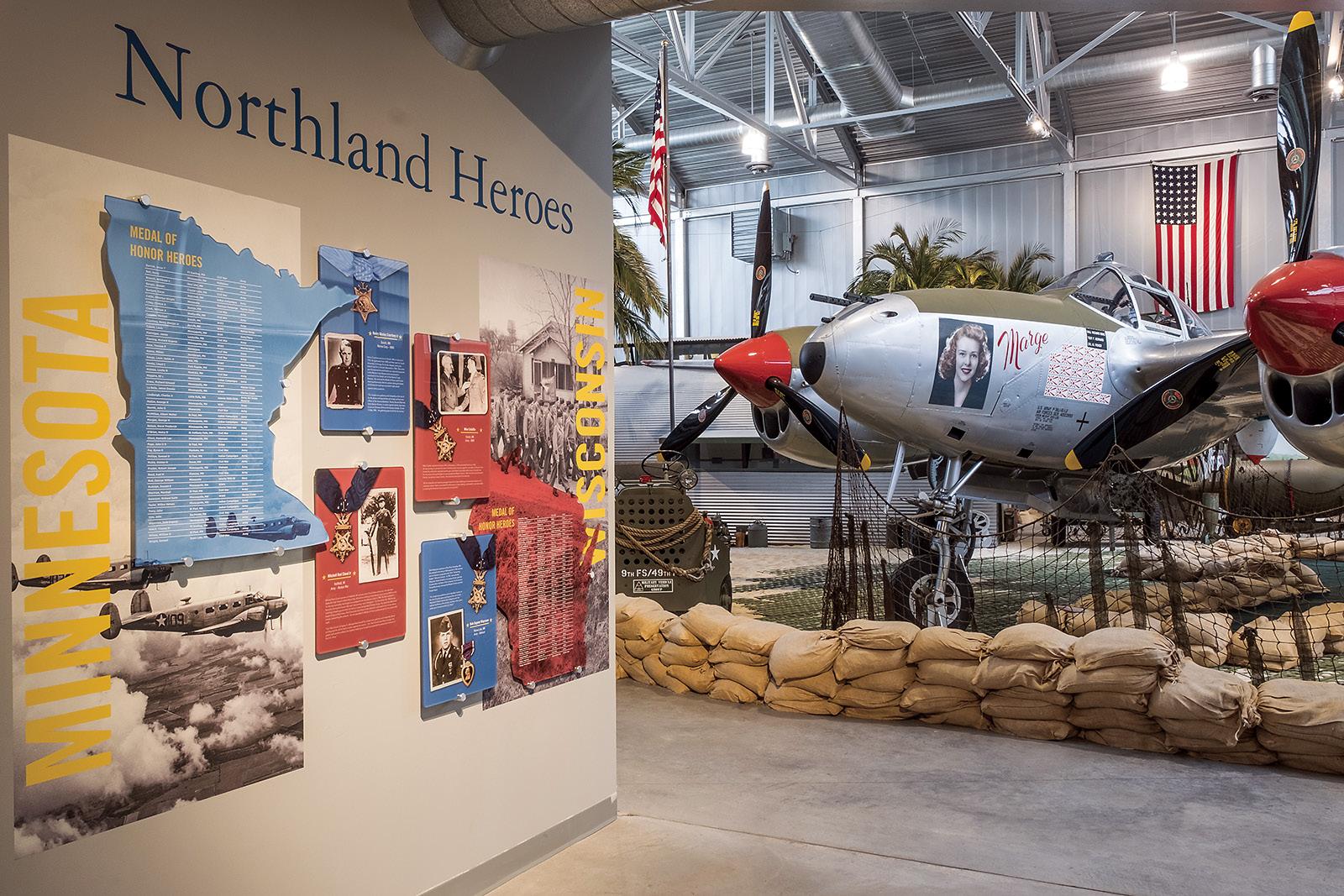
The Genuine. The Original.
O V E R H E A D D O O R Overhead Door Company of Duluth
4214 Airpark Blvd. Duluth, MN 55811 24 hour service Phone 218-722-2884 www.ohdnorthernmn.com
Cabins - Camping - Fishing Hiking - Canoeing
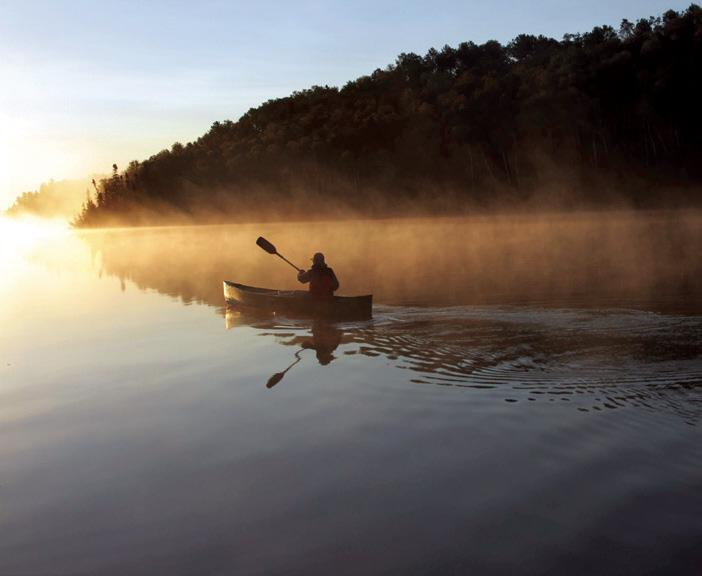
www.Golden-Eagle.com 800-346-2203
The Richard I. Bong Veteran’s Historical Center in Superior contains over 10,000 artifacts, as well as an impressive archive of over 3,000 books, personal letters, photographs, and more. | SUBMITTED
A history of the sky: Aviation Museums
NORTH SHORE—The roar of an F-16 fighter jet passing overhead is a sound that isn’t so much heard as it is felt by a person watching from ground level.
Anyone who has spent significant time on the North Shore is familiar with that roar, and has had a moment interrupted by a fighter jet’s awesome rumble as the 148th Fighter Wing, based out of Duluth, runs a routine practice flight along Superior’s shore.
The F-16’s based out of Duluth, along with the commercial airliners that pass by 35,000 feet up in the sky and the modern personal jets designed and manufactured by the locally headquartered Cirrus Aircraft, are but the most recent chapter in aviation history on the North Shore.
North Shore aviation has a fascinating history, one well worth discovering. The following are a few of the different organizations in the region that dedicate themselves to the continued preservation of aviation history on the North Shore.
RICHARD I. BONG VETERAN’S HISTORICAL CENTER
The Richard I. Bong Veteran’s Historical Center, located at 305 Harbor View Parkway in Superior, Wisc., is a must-see for anyone who fancies themselves an aviation enthusiast.
What started as a foundation to raise funds for a Richard Ira Bong memorial, is now a much larger organization whose mission has expanded to not only preserve and honor the memory of Major Bong, but to do so for “all veterans of World War II and the subsequent conflicts by providing educational resources for the Twin Ports area community and beyond.”
The Historical Center is home to a stateof-the-art museum that boasts an impressive collection of over 10,000 artifacts, as well as archives containing over 3,000 books, manuscripts, yearbooks, personal letters, photographs, scrapbooks and newspapers. A P-38 fighter plane—donated by the American Legion Post 435 in 2000—stands impressively in the center of the museum in honor of Major Richard I. Bong.
Fascinating and engaging—the museum is well worth the visit.
Now offering


Tax Services
COOK COUNTY HOME CENTER
Mon - Fri: 7 am - 5 pm
Sat: 8 am - 2 pm, Sun: Closed 1413 E. Hwy 61, Grand Marais 218-387-1771 Toll-free 1-877-387-1771
Silver Bay
30 Shopping Center PO Box 68 Silver Bay, MN 55614 218-226-4383
Two Harbors
526 7th Street PO Box A Two Harbors, MN 55616 218-834-3600
According to the historical center, Richard I. Bong was a WWII fighter pilot who became the United States’ all-time “Ace of Aces” during the war, “downing 40 enemy planes in the Pacific Theater of the war while flying P-38 fighter planes.” Major Bong was eventually sent home by General George C. Kenney to marry his sweetheart, Marge, and start a family in Superior.
Born and raised on a farm in nearby Poplar, Wisc., Richard I. Bong’s upbringing “epitomized the values and expectations of that era,” making him a true American hero. Major Bong was awarded the Congressional Medal of Honor by General Douglas MacArthur in 1944, a year before Richard Bong’s tragic death during a test flight of a new P-80 Fighter Jet.
While Major Bong may be gone, his story—along with the stories of other veterans from WWII and subsequent conflicts—lives on in the Veteran’s Historical Center that bears his name.
For up to date hours, events, and information on the Richard I. Bong Veteran’s Historical Center and its mission, visit: bongcenter.org.
NORTHWESTERN ONTARIO AVIATION HERITAGE CENTER
On the other end of the shore from the Bong Museum, the Northwestern Ontario Aviation Heritage Center (NOAHC) is an organization dedicated to the continued preservation of aviation history in the North. The NOAHC covers aviation history in an area that expands across nearly 50 percent of Ontario—526,372 square kilometers—making it a regional center despite its location in Thunder Bay.
The idea for the heritage center first came about in 2006 when the retired aeronautical engineer Victor Stevenson brought together a group of aviation enthusiasts with the goal of establishing a museum to preserve the story of the Canadian Car and Foundry’s (Can-Car) contribution to aviation history. Though not limited to producing planes during wartime, Can-Car is best known for the Hawker Hurricane fighters and Curtiss SB2C Helldivers that it manufactured during WWII.
As the aviation “enthusiasts” continued to work towards establishing a museum, however, it became apparent that there was a larger story beyond Can-Car that needed to be told, a story that included both “the civilian and military history of aviation in the region with all of its tales of heroism, courage, ingenuity, laughter, and tragedy,” as described on the NOAHC webpage.
Established in 2008, the museum today not only takes visitors through Can-Car’s story and the 4,000 “Rosie’s of the North” that contributed planes throughout WWII, but also immerses its visitors in the daring tales of the bush pilots that made life and industry in the remote North possible.
Exhibits are well laid out and easy to follow, with photos and artifacts on display that take the viewer back to a time before modern navigation aids and accurate weather reports, when flying was, to quote the NOAHC, “a seat-ofthe-pants affair.”
For further information on Northwestern Ontario Heritage Center events, hours, and special tours, visit their website at: noahc.org.
The Richard I. Bong Veteran’s Historical Center is a must-see for any aviation enthusiast.
| SUBMITTED
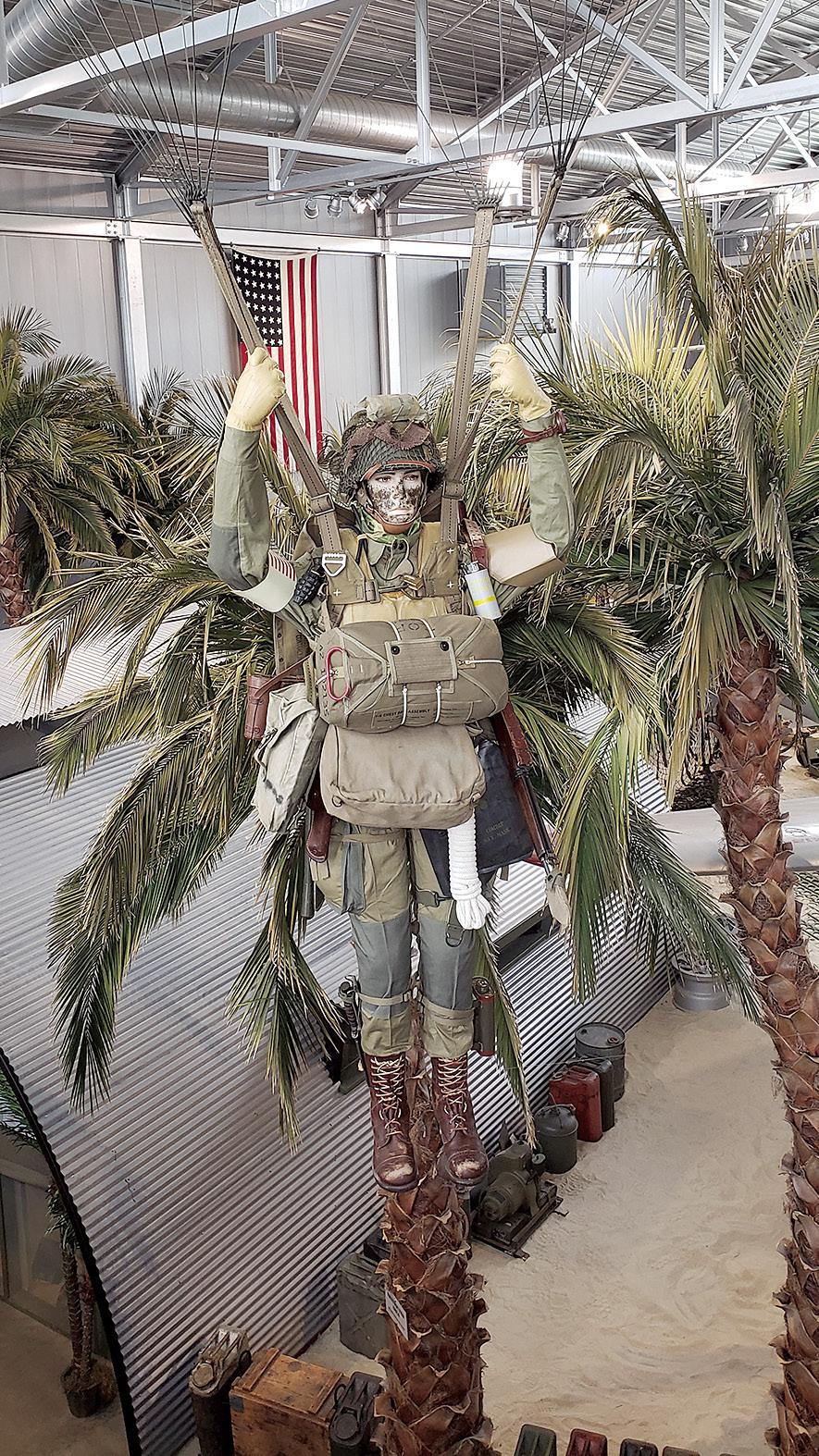
DISCOVER GERALDTON INTERPRETIVE CENTER
In addition to the Richard I. Bong Veteran’s historical center and the NOAHC, the Discover Geraldton Interpretive Center (GIC) is an interpretive center that delves into aviation history in its telling of the region’s history.
Located in Geraldton, Ontario along Highway 11, the discover GIC offers visitors the opportunity to “explore the early days of the Hudson Bay Fur Traders, the gold boom that brought the town of Geraldton into being, and the firefighting legacy that is ours today.”
Further information to events and summer hours can be found on their webpage at: bit.ly/greenstoneic.—Eric Weicht
The North Shore’s full-fiber broadband network, providing phone & internet service throughout Cook County.
EXPLO RE THE SO UTH SHO RE

